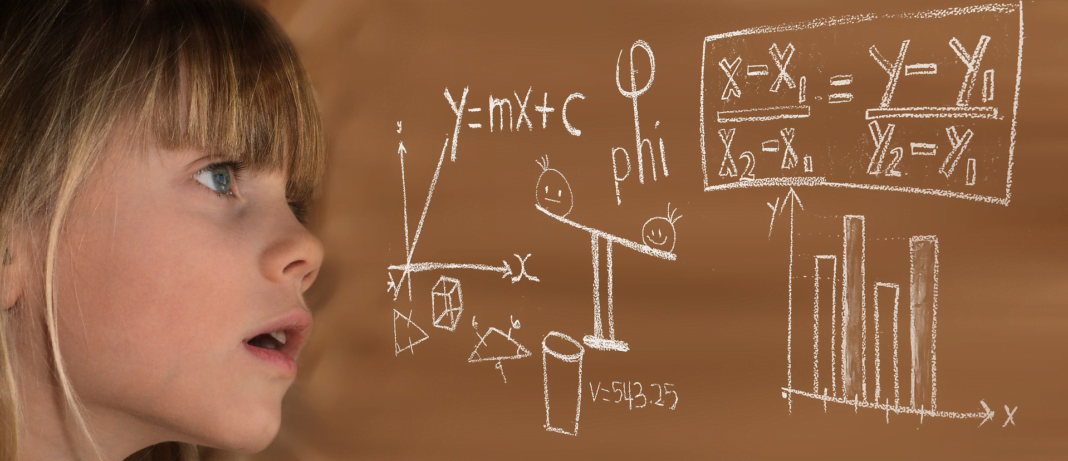The Singapore math model is a highly effective teaching method that was developed to teach children in Singapore primary schools. It enables children to clearly and visually see the math question. Since its conception, the method has been adopted in dozens of countries and has received exceedingly positive reviews from educators and students around the globe.
The method is based on a series of long-established math theories and is the product of several blended international ideas, teaching methods, and other resources.
Alt: A young girl looks at white drawings of mathematical problems and formulas on a brown background.
How does it work?
In the 1960s, American psychologist Jerome Bruner found that people often learn in three stages by first utilizing “real” objects before transitioning to pictures, and then to symbols.
The core principle of the Singapore math model is that it is a three-step learning process—or the Concrete Pictorial Abstract (CPA) Approach—which teaches students to grasp fewer mathematical concepts in greater detail. The three steps through which students are taught introduces concepts in a tangible, solid way, and then transitions into more abstract concepts: the concrete step, the pictorial step, and the abstract step.
The Concrete Step
The first of the three steps is the concrete step. In this phase, students learn while handling real, tangible objects—such as dice, paper clips, or blocks. Students count the objects by physically lining them up in a row, and then learn the basic operations of arithmetic such as addition or subtraction by adding or removing the objects from each row.
In the first step, mathematical concepts become more grounded as students engage in hands-on learning experiences using physical, everyday objects.
The Pictorial Step
The concrete step is followed by drawing visual representations of mathematical concepts. Students will learn to represent specific quantities of an object by drawing diagrams called “bar models,” which involves drawing a rectangular bar to represent a specific quantity. For example, if a small bar represents five paper clips, a bar that is twice as big would represent ten.
By learning to visualize the difference between the two bars, students learn to solve problems of addition by adding one bar to the other. Using this method, they can learn to solve other mathematical problems involving subtraction, multiplication, and division.
The Abstract Step
Finally, once students have learned to solve mathematical problems using bar modeling, they move on to the third and final step: the abstract step. Students begin to solve mathematical problems with strictly abstract tools like numbers and symbols.
This step connects the previous steps (concrete and pictorial) together in the learner’s mind. Reaching this milestone allows the students to solve problems without needing pictures or examples of the problem they are finding the answer to. As such, this final step marks the success of the Singapore math method.
Pros and Cons of the Singapore Math Model Method
There are both pros and cons to the Singapore math model method. The method is a wonderful tool for children who are visual learners as it gives a better picture of a more abstract question. As opposed to using letters to represent numbers, as is done in algebra, using blocks or other recognizable objects to represent numbers can be more visually appealing to young minds.
By seeing the question visually, the method shows the “part-whole relationship” between numbers, and children are better able to see the logic between different objects. Drawing models can help students understand math concepts more clearly, especially fractions and ratios.
The bar-modeling method can help students visualize a range of math concepts, such as fractions, ratios, and percentages, and teaches them to determine the knowns and unknowns in a given mathematical situation.
A drawback to using this method is that, for some, it may seem time-consuming and tedious if children can see the flow and solution in their minds. If they dislike drawing, some children might find this method unnecessary, while others might prefer to write down statements to see the flow of the math process instead of drawing models.
When to use this method?
One situation in which using this method is particularly useful is when dealing with fractions. As learning and using fractions involves working with parts of a whole, the visual element of the Singapore math model is particularly useful in grounding the understanding of addition or subtraction of these more abstract math ideas.
History of the Singapore math model
The approach is based on recommendations from experts such as psychologist Jerome Bruner, mathematician and pioneer in math education Richard Skemp, child psychologists Jean Piaget and Lev Vygotsky, and psychologist Zoltan Dienes.
Considering the work of psychologist Jerome Bruner, the development of Singapore math model method began in the 1980s when the Ministry of Education of Singapore developed its own mathematics textbooks that concentrated on developing thinking skills and problem-solving. In recent decades, these textbooks have gone on to be adopted by several schools in the United States, Canada, Israel, the Philippines, and the United Kingdom.
Worldwide reception of the method
The success of the Singapore math model method is apparent as it has produced a world-class level of achievement for many years, as Singapore regularly ranks at the top in international math testing. Since the release of scores from international education surveys, textbooks that teach the Singapore math model method have become more popular, and early adopters of the method in the United States included parents interested in homeschooling as well as a number of private and charter schools.
The Singapore math method is helping to unlock the learning potential of students all over the world. This learning method not only teaches the learner how to solve math problems, but it can also be applied to other problems the student has to solve outside of the classroom by enabling them to think abstractly.
Conclusion
For some learners, adopting this approach has the potential to boost confidence in their math abilities, and may even help with getting homework done faster. Overall, the Singapore math model helps students develop number sense and flexibility in thinking about numbers, and has the proven results to back it up.
Related Posts:







